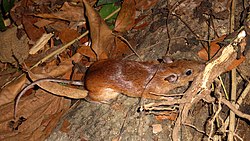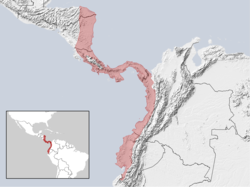| Common name | Scientific name and subspecies | Range | Size and ecology | IUCN status and estimated population |
|---|
| Boyacá spiny rat
| P. chrysaeolus
(Thomas, 1898) | Colombia | Size: 21–22 cm (8–9 in) long, plus 14–16 cm (6 in) tail [24]
Habitat: Forest [65]
Diet: Wide variety of vegetation [66] | DD
Unknown  [65] [65]
|
|---|
| Colombian spiny rat
| P. canicollis
(Allen, 1899) | Colombia and Venezuela | Size: About 22 cm (9 in) long, plus about 17 cm (7 in) tail [9]
Habitat: Forest [67]
Diet: Wide variety of vegetation [66] | LC
Unknown  [67] [67]
|
|---|
| Cuvier's spiny rat
| P. cuvieri
Petter, 1978 | Northern South America | Size: 21–23 cm (8–9 in) long, plus 14–17 cm (6–7 in) tail [24]
Habitat: Forest
Diet: Wide variety of vegetation [66] | LC
Unknown 
|
|---|
| Gardner's spiny rat
| P. gardneri
Silva, 1998 | Bolivia and western Brazil | Size: 15–21 cm (6–8 in) long, plus 8–16 cm (3–6 in) tail [24]
Habitat: Forest
Diet: Wide variety of vegetation [66] | DD
Unknown 
|
|---|
| Goeldi's spiny rat
| P. goeldii
Thomas, 1905 | Central Brazil | Size: 18–27 cm (7–11 in) long, plus 10–18 cm (4–7 in) tail [24]
Habitat: Forest [70]
Diet: Wide variety of vegetation [66] | LC
Unknown  [70] [70]
|
|---|
| Guaira spiny rat
| P. guairae
Thomas, 1901 | Colombia and Venezuela | Size: 21–24 cm (8–9 in) long, plus 17–20 cm (7–8 in) tail [24]
Habitat: Forest [71]
Diet: Wide variety of vegetation [66] | LC
Unknown  [71] [71]
|
|---|
| Guyanan spiny-rat
| P. hoplomyoides
Tate, 1939 | Northern South America | Size: About 21 cm (8 in) long, plus about 15 cm (6 in) tail [24]
Habitat: Forest [72]
Diet: Wide variety of vegetation [66] | DD
Unknown  [72] [72]
|
|---|
| Guyenne spiny rat  | P. guyannensis
(Geoffroy, 1803)
- P. g. arabupu
- P. g. arescens
- P. g. cherriei
- P. g. guyannensis
- P. g. riparum
- P. g. vacillator
| Northern South America | Size: 18–23 cm (7–9 in) long, plus 11–19 cm (4–7 in) tail [24]
Habitat: Forest [73]
Diet: Wide variety of vegetation [66] | LC
Unknown  [73] [73]
|
|---|
| Kulina spiny rat
| P. kulinae
Silva, 1998 | Peru and western Brazil | Size: 14–19 cm (6–7 in) long, plus 9–14 cm (4–6 in) tail [24]
Habitat: Forest [74]
Diet: Wide variety of vegetation [66] | DD
Unknown  [74] [74]
|
|---|
| Long-tailed spiny rat  | P. longicaudatus
(Rengger, 1830) | Central South America | Size: 22–25 cm (9–10 in) long, plus 13–15 cm (5–6 in) tail [24]
Habitat: Forest [75]
Diet: Wide variety of vegetation [66] | LC
Unknown  [75] [75]
|
|---|
| Minca spiny rat
| P. mincae
(Allen, 1899) | Northern Colombia | Size: 22–23 cm (9 in) long, plus 20–21 cm (8 in) tail [24]
Habitat: Forest [76]
Diet: Wide variety of vegetation [66] | DD
Unknown  [76] [76]
|
|---|
| Napo spiny rat
| P. quadruplicatus
Hershkovitz, 1948 | Northern South America
 | Size: 21–29 cm (8–11 in) long, plus 12–20 cm (5–8 in) tail [9]
Habitat: Forest [77]
Diet: Wide variety of vegetation [66] | LC
Unknown  [77] [77]
|
|---|
| O'Connell's spiny rat
| P. oconnelli
Allen, 1913 | Colombia | Size: About 25 cm (10 in) long, plus 18 cm (7 in) tail [9]
Habitat: Forest [78]
Diet: Wide variety of vegetation [66] | DD
Unknown  [78] [78]
|
|---|
| Pacific spiny rat
| P. decumanus
(Thomas, 1899) | Ecuador and Peru | Size: 26–30 cm (10–12 in) long, plus about 20 cm (8 in) tail [9]
Habitat: Forest [79]
Diet: Wide variety of vegetation [66] | NT
Unknown  [79] [79]
|
|---|
| Patton's spiny rat
| P. pattoni
Silva, 1998 | Peru and western Brazil | Size: 14–20 cm (6–8 in) long, plus 10–15 cm (4–6 in) tail [24]
Habitat: Forest [80]
Diet: Wide variety of vegetation [66] | LC
Unknown  [80] [80]
|
|---|
| Robert's spiny rat
| P. roberti
Thomas, 1901 | Central Brazil
 | Size: 20–23 cm (8–9 in) long, plus about 16 cm (6 in) tail [24]
Habitat: Forest and savanna [81]
Diet: Wide variety of vegetation [66] | LC
Unknown  [81] [81]
|
|---|
| Short-tailed spiny rat
| P. brevicauda
(Günther, 1877) | Western South America | Size: 18–25 cm (7–10 in) long, plus 13–17 cm (5–7 in) tail [24]
Habitat: Forest [82]
Diet: Wide variety of vegetation [66] | LC
Unknown  [82] [82]
|
|---|
| Simons's spiny rat
| P. simonsi
Thomas, 1900 | Western South America
 | Size: 16–27 cm (6–11 in) long, plus 11–23 cm (4–9 in) tail [9]
Habitat: Forest [83]
Diet: Wide variety of vegetation [66] | LC
Unknown  [83] [83]
|
|---|
| Steere's spiny rat
| P. steerei
Goldman, 1911 | Western South America
 | Size: 21–29 cm (8–11 in) long, plus 12–21 cm (5–8 in) tail [24]
Habitat: Forest [84]
Diet: Wide variety of vegetation [66] | LC
Unknown  [84] [84]
|
|---|
| Stiff-spine spiny rat
| P. echinothrix
Silva, 1998 | Western Brazil | Size: 14–24 cm (6–9 in) long, plus 10–21 cm (4–8 in) tail [9]
Habitat: Forest [85]
Diet: Wide variety of vegetation [66] | LC
Unknown  [85] [85]
|
|---|
| Tome's spiny rat  | P. semispinosus
(Tomes, 1860)
- P. s. burrus
- P. s. calidior
- P. s. centralis
- P. s. colombianus
- P. s. goldmani
- P. s. ignotus
- P. s. panamensis
- P. s. rosa
- P. s. rubellus
- P. s. semispinosus
| Central America and northwestern South America
 | Size: About 29 cm (11 in) long, plus about 24 cm (9 in) tail [9]
Habitat: Forest [86]
Diet: Wide variety of vegetation [66] | LC
Unknown  [86] [86]
|
|---|
| Trinidad spiny rat
| P. trinitatus
(Allen & Chapman, 1893) | Northern Venezuela
 | Size: 26–27 cm (10–11 in) long, plus 20–21 cm (8–8 in) tail [24]
Habitat: Forest [87]
Diet: Wide variety of vegetation [66] | DD
Unknown  [87] [87]
|
|---|













































